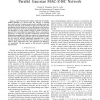Free Online Productivity Tools
i2Speak
i2Symbol
i2OCR
iTex2Img
iWeb2Print
iWeb2Shot
i2Type
iPdf2Split
iPdf2Merge
i2Bopomofo
i2Arabic
i2Style
i2Image
i2PDF
iLatex2Rtf
Sci2ools
89
Voted
CORR
2010
Springer
2010
Springer
Sum-Capacity and the Unique Separability of the Parallel Gaussian MAC-Z-BC Network
—THIS PAPER IS ELIGIBLE FOR THE STUDENT PAPER AWARD. It is known that the capacity of parallel (e.g., multi-carrier) Gaussian point-to-point, multiple access and broadcast channels can be achieved by separate encoding for each subchannel (carrier) subject to a power allocation across carriers. Recent results have shown that parallel interference channels are not separable, i.e., joint coding is needed to achieve capacity in general. This work studies the separability, from a sum-capacity perspective, of single hop Gaussian interference networks with independent messages and arbitrary number of transmitters and receivers. The main result is that the only network that is always (for all values of channel coefficients) separable from a sumcapacity perspective is the MAC-Z-BC network, i.e., a network where a MAC component and a BC component are linked by a Z component. The sum capacity of this network is explicitly characterized.
CORR 2010 | Education | Hop Gaussian Interference | Parallel Interference Channels | STUDENT PAPER AWARD |
| Added | 24 Jan 2011 |
| Updated | 24 Jan 2011 |
| Type | Journal |
| Year | 2010 |
| Where | CORR |
| Authors | Viveck R. Cadambe, Syed Ali Jafar |
Comments (0)

